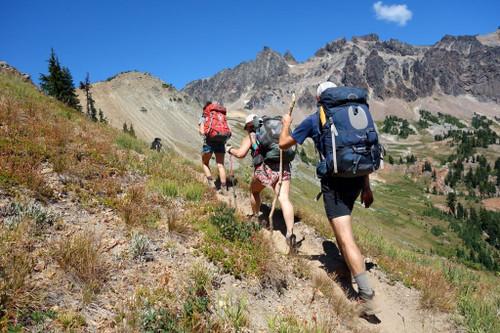Summiting Peaks: Conquering Hiking Without the Chafing Challenge
Posted by Jack Miller on 10th Feb 2024
Hiking up a mountain is a thrilling adventure that brings you closer to nature's majesty. However, along with the breathtaking views and sense of accomplishment, there's the potential for an uncomfortable companion: chafing. In this blog post, we'll explore how the unique demands of mountain hiking can contribute to chafing and share tips to ensure a seamless ascent without the burn.
Elevation and Climate - The Factors at Play
Mountain hikes often involve changes in elevation and varying climates. As you ascend, the air becomes thinner, and temperatures can fluctuate dramatically. These factors can influence your body's response, including sweating and changes in skin sensitivity, contributing to the potential for chafe.
Chafing Solutions for Changing Conditions
Dress in layers to regulate body temperature as you ascend and descend. Choose moisture-wicking fabrics to keep sweat away from the skin. Pack extra clothing to adapt to climate changes and stay dry.
Prolonged Movement and Friction
Mountain hiking is a demanding physical activity that engages various muscle groups. The continuous movement, particularly during an uphill climb, can lead to increased friction in areas like underarms, lower back and inner thigh chafing. Prolonged exposure to moisture from sweat further heightens the risk of chafing.
Chafing Solutions for Intense Hiking
Wear moisture-wicking and breathable clothing to minimize sweat retention. Invest in quality hiking gear, including well-fitted boots and moisture-wicking socks. Apply anti-chafing balms or creams before starting the hike, focusing on high-friction areas.
The Impact of Gear on Chafing
Carrying a backpack during a mountain hike is standard practice, but it can introduce a new set of challenges. The constant rubbing of shoulder straps and the pressure exerted on the lower back can lead to chafing, especially if the backpack is not properly adjusted.
Chafing Solutions for Backpack Woes
Ensure your backpack is fitted correctly to distribute weight evenly. Use padding or cushions on shoulder straps to reduce friction. Consider wearing a moisture-wicking base layer between your skin and the backpack.
Uneven Ground and Potential Abrasion
Mountain trails are diverse, ranging from well-groomed paths to rocky and uneven terrain. The type of trail can impact your gait and introduce new challenges for chafing, particularly in areas where skin-on-skin contact is frequent.
Chafing Solutions for Trail Challenges
Choose moisture-wicking and quick-drying clothing suitable for the trail type. Wear compression shorts or leggings to minimize skin contact and friction. Take breaks to assess and adjust clothing to prevent abrasion in high-friction zones. The best chafing solution is thigh bands, make sure to wear these before any hiking trip.
Conquering a mountain is a rewarding endeavor, and with proper preparation, you can minimize the risk of chafing and fully embrace the journey. By understanding the factors unique to mountain hiking—such as changing elevations, intense physical activity, backpack considerations, and trail terrain—you can tailor your approach to ensure a comfortable and chafe-free ascent. So, lace up those hiking boots, pack wisely, and ascend the peaks with confidence, knowing that you've conquered both the mountain and the potential for chafing along the way.

